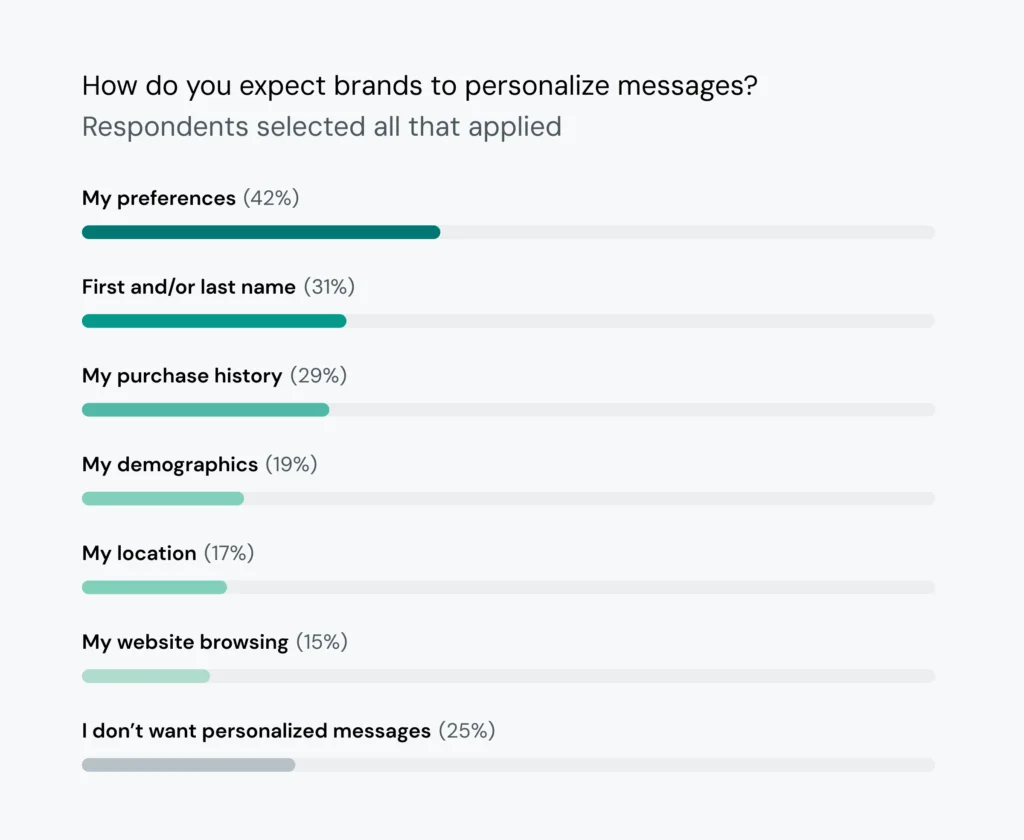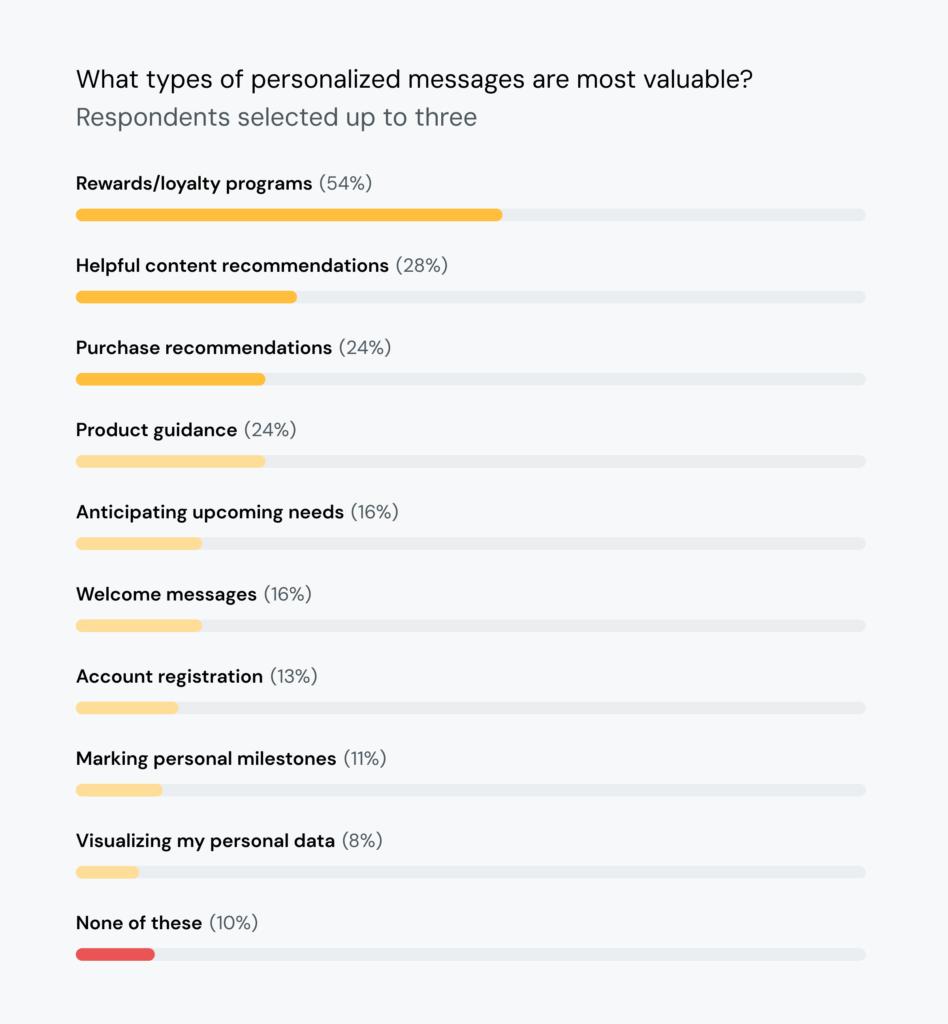Insights
Win customers with omnichannel personalization

Insights

Switching from one customer service channel to another shouldn’t feel like starting from scratch. Yet our 2025 State of customer communications survey shows that 81% of consumers report frustration when they have to repeat information after moving between digital channels.
There’s a huge gap between what customers expect and what most businesses deliver. While many companies have adopted multichannel approaches, they’re still operating in silos that create friction rather than flow across the customer journey.
The solution lies in omnichannel personalization – a marketing strategy that connects customer data and conversations across every digital touchpoint. Let’s explore what you need to know about personalization in an omnichannel experience.
Omnichannel personalization is the practice of creating a single, consistent experience and personalized customer journey across every channel they use. Context, preferences, and real-time data move with them, so no matter where the conversation goes, it feels seamless.
Unlike multichannel marketing, which means simply using multiple platforms to reach customers, omnichannel personalization breaks down the walls between channels. Think of it as the difference between having separate conversations with different departments versus talking to one knowledgeable representative who knows your entire customer profile.
When an individual customer starts a conversation on your website chat and continues it via SMS or a mobile app, they shouldn’t have to explain their situation twice.
And while 59% of businesses say that their communication channels are fully integrated, building a truly personalized cross-channel experience is still an advantage for industry leaders who get it right.
Customer expectations have hit a tipping point. What used to be a nice-to-have is now the minimum standard. If your communication channels aren’t connected, customers will move on to competitors that have optimized their customer engagement.
Here are three reasons why brands can’t afford to wait:
Customer behavior has shifted from passive acceptance to active demand for control and personalization.
Our research shows that 58% of consumers want to choose their preferred channel when they opt in to communications. They expect brands to meet them where they’re most comfortable across digital channels, social media, and mobile apps.
Additionally, 42% of consumers expect promotions that are tailored to their preferences, moving beyond generic mass marketing towards personalized customer experiences.

These expectations create a clear mandate: brands that continue sending one-size-fits-all messages through channels customers didn’t choose will see conversion rates plummet.
Personalized content respects channel preferences while delivering relevant messaging across each touchpoint to meet customer needs.
Nothing destroys customer satisfaction faster than having to repeat information every time they switch channels.
Our 2025 research found that 81% of consumers have a negative reaction to repeating information when dealing with support, with 42% finding it frustrating and 24% saying it wastes their time and disrupts their experience.
of consumers have a negative reaction to having to repeat information when they deal with support.
of consumers say having to repeat information to support is frustrating.
This frustration stems from disconnected systems where your email support team has no visibility into previous SMS conversation or chat history. Omnichannel personalization eliminates this pain point by making customer context, preferences, and interaction history accessible across all digital touchpoints to improve the overall customer experience.
Letting customers pick up where they left off, regardless of channel, dramatically improves both their experience and loyalty.
Omnichannel personalization delivers measurable returns and improves key metrics.
French retailer BUT partnered with Sinch to implement a unified messaging strategy across WhatsApp, RCS, and Rich SMS, resulting in doubled ROI and enhanced customer lifetime value compared to traditional campaigns.
Their cross-channel approach generated impressive results. One RCS campaign achieved a 13.3% click rate and €61,000 in additional turnover, while their WhatsApp integration expanded customer acquisition by 123%.
The strategy’s success came from meeting customers on their preferred channels while maintaining consistent, personalized marketing across touchpoints.
Building effective personalization efforts requires the right approach, technology, and data integration. Here’s a step-by-step framework for marketing teams:
Personalization can only be as strong as the customer data platform (CDP) behind it. Too often, information about customer interactions sits in disconnected systems, making it impossible to deliver a consistent digital experience and understand behavior patterns.
According to our 2025 survey, 38% of businesses say that integrating communications with other systems is one of their top three challenges.
Breaking down these silos gives every channel access to the same context and customer profiles, whether it’s order history, service requests, or preferences. As data flows freely through workflows, you can create smooth, relevant interactions that enhance the customer experience and strengthen connections at every touchpoint.
Customers want control over how they hear from you, and their preferences change depending on the type of message and the decision-making process.
Our survey shows that 77% of consumers prefer promotional messages by email, while 36% want informational updates across multiple digital channels, including mobile apps and social media.
A single-channel approach won’t cut it – your marketing strategy should flex to match the purpose of the communication and customer segmentation. Offering customers a choice of channels respects their time and attention and makes it more likely they’ll engage. When people feel in control, they’re more receptive to what your brand has to say.
of consumers want promotional messages by email.
of consumers want informational updates across multiple digital channels.
With artificial intelligence and machine learning, you can use automation to analyze customer behavior in real time, predict customer needs, and tailor messages before they ask.
Our 2025 survey shows that the shift is already happening: 44% of businesses already use AI for personalization efforts, while 47% apply it for predictive communications. That means brands are moving from reactive outreach to proactive engagement.
From product recommendations to automating support conversations, AI helps every interaction feel relevant and timely while supporting functions that orchestrate personalized marketing across channels.
Personalization should extend beyond marketing campaigns to flow into customer service and transactional messages. Mapping the customer journey across the entire experience ensures consistency at every stage.
Our State of customer communications research found that 54% of consumers value personalized rewards and customer loyalty messages the most, showing how tailored experiences can deepen relationships.

By mapping the entire customer journey, you can deliver messages across different channels that resonate with consumers at every touchpoint to make an experience that feels uniquely like your brand.
Different industries face unique customer communication challenges and opportunities. Here are use cases showing how leading companies across key sectors are applying omnichannel personalization:
Retailers and e-commerce businesses gain the most from omnichannel personalization software when they connect the dots across the buying journey. Cart reminders sent through interactive messaging let customers review items, apply discounts, and complete checkout in a few taps, improving conversion rates both online and in-store.
The same approach can optimize returns. 76% of consumers are open to handling returns and exchanges through messaging apps rather than in-person visits. Providing this option turns a frustrating process into a personalized experience.
For retailers, the result is fewer abandoned purchases, higher completion rates, and stronger customer loyalty after the sale.
In financial services, every interaction carries weight, since customers expect both speed and reassurance. This is especially true when their money or identity may be at risk and they need to make important choices.
Our report highlights digital banking trends showing that 72% of consumers expect fraud alerts to arrive immediately, yet 46% still prefer a voice call to resolve the issue.
This signals a dual need: instant alerts through digital channels to flag potential problems, followed by human support to address them through in-person or voice interactions.
Channels with verified sender information, such as RCS or WhatsApp, help confirm messages are authentic. By combining trusted digital touchpoints with quick, secure follow-up, financial institutions can strengthen confidence and protect relationships while meeting individual customer preferences.
Cross-channel messaging gives healthcare providers a direct way to improve outcomes and reduce inefficiencies while balancing digital and in-person care. Missed appointments are a major cost driver, yet research shows that 32% of patients are likely to miss a visit without a reminder.
Upgrading reminders across SMS, email, mobile apps, or WhatsApp helps patients stay on schedule and raises satisfaction by making the process more convenient and optimizing the user experience.
Artificial intelligence can also play a role, but privacy concerns remain. While 40% of consumers we surveyed expressed they’d be uncomfortable with using a healthcare chatbot, their comfort level increased a bit when it came with the benefit of receiving care faster. In that case, 41% of consumers would use AI, even if they were doing something as sensitive as describing their symptom to a chatbot.

Use machine learning and automation to ease critical pain points – like long wait times – while ensuring that sensitive interactions remain secure and human-centered.
By 2025, customers expect brands to recognize them across every channel, whether they start a chat, open an email, or call support.
Meeting that expectation depends on technology, like a customer data platform that connects data and conversations in real time. Without it, even the best personalization efforts break down into disjointed interactions.
The right omnichannel personalization platform makes it easy to integrate channels, share context, and expand as new preferences emerge – all while supporting marketing teams with streamlined workflows. Solutions like the Sinch Conversation API simplify this by providing one connection point for all messaging channels like SMS, RCS, and WhatsApp.
Teams can focus on building meaningful interactions and personalized content instead of stitching together disconnected tools. The outcome is consistency for customers and efficiency for organizations that need to orchestrate seamless experiences.
Omnichannel marketing comes down to three essentials: connecting your real-time data, respecting customer channel preferences, and applying personalization consistently across marketing, service, and transactional digital touchpoints. Done right, it reduces friction, builds trust, and improves customer retention and metrics – all while proving measurable ROI and increasing customer lifetime value.
The State of customer communications report shares data on where customers feel let down and highlights how businesses are closing those gaps.
Get a clear view of what people expect in 2025 and the practical steps brands can take to meet them through optimized personalization efforts.